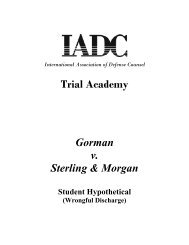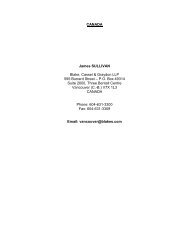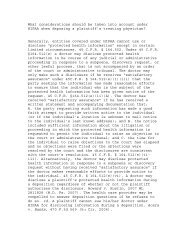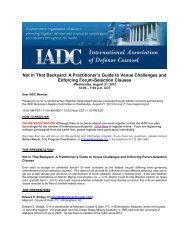Defense Counsel Journal - International Association of Defense ...
Defense Counsel Journal - International Association of Defense ...
Defense Counsel Journal - International Association of Defense ...
Create successful ePaper yourself
Turn your PDF publications into a flip-book with our unique Google optimized e-Paper software.
Raising the Ro<strong>of</strong> Page 475The question <strong>of</strong> whether defectiveconstruction is an “occurrence” askswhether the loss itself is the typecontemplated by the policy. Only if theanswer to that question is “Yes” is thereany need to consider whether any otherprovision <strong>of</strong> the policy precludes thatcoverage. Therefore, the Court’s relianceon U.S. Fire’s failure to use clearpreclusionary language in support <strong>of</strong> itsconclusion that defective constructionconstitutes an “occurrence” isnonsensical. Its analysis demonstratesthat the Court never really analyzedwhether defective construction isaccidental or fortuitous. Rather, it simplycited to changes in the relevant exclusionsto justify its departure from decades <strong>of</strong>settled precedent.E. Harmonization <strong>of</strong> theDecisionsDespite what appear to be a fairlysignificant divergence <strong>of</strong> views on thescope <strong>of</strong> coverage under the broad formgeneral liability policy, the reality is thatonly in a few states will builders have theequivalent <strong>of</strong> performance bond coverage(but without the insurer’s concomitantright to recoup any payments thereunderfrom the insured). Obviously, contractorsin Florida and Texas and the other stateswhich apply their rationale (see AppendixI) will enjoy broad coverage. Even inthose states, it is fair to assume that workdone by the contractor itself will not becovered. In J.S.U.B., the contractor subcontractedall <strong>of</strong> the work on the home.Therefore, all <strong>of</strong> the property damage wascovered. But even the J.S.U.B. decisionmakes it fairly clear that defective workthat is performed by the contractor itselfwill not be covered.As a result, we discern a broad themerunning through the great majority <strong>of</strong>decisions, such that several broadprinciples <strong>of</strong> law can be said to be theoverwhelming majority rule. First, claims<strong>of</strong> defective construction, standing alone,do not meet the element <strong>of</strong> fortuitynecessary to constitute an accident andare therefore not covered. Second, wherethe work in question was performed by asubcontractor, the damage is eitherconsidered accidental from the standpoint<strong>of</strong> the insured or fits within thesubcontractor exception to the “yourwork” exclusion. Third, to the extent theinsured’s defective work results indamage to other property not the subject<strong>of</strong> the insured’s work, that damage islikely covered. In essence, after fortytwoyears <strong>of</strong> litigation, we end up at thesame place Dean Henderson described in1971. 24II. Other IssuesIn the aftermath <strong>of</strong> the constructiondefect litigation explosion, insurers,claims pr<strong>of</strong>essionals and attorneyscontinue to struggle with other issues.While it is simple to say that damage tothe insured’s work is not covered,application <strong>of</strong> that principle is moredifficult, particularly in the context <strong>of</strong> theall-too-common water intrusion claimthat seems to define much <strong>of</strong> the currentlitigation. In the event the stucco isdefective, resulting in rotting <strong>of</strong> structuralframing members and damage to drywall,how do we parse the cost <strong>of</strong> removing24 See supra note 8.












